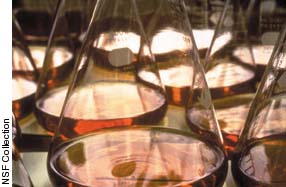
The Board's Bestseller
In 1972, the Board welcomed as NSF Director physicist H. Guyford Stever, former president of Carnegie Mellon University. Board members had been debating possible topics for the fifth annual NSB report. Member Roger W. Heyns, a social psychologist and president of the American Council on Education, suggested that the Board regularly publish data on scientific manpower and funds. Stever recalls that the idea was adopted quickly, with Heyns tapped to head the project.
 In hindsight, the need for a popular publication with regularly updated data series was obvious. Though
the Foundation had gathered some data since the beginning, as required by the 1950 Act, the Board and
others still did not have systematic information with which to bolster their arguments concerning funding
and manpower needs. How many students were in the educational pipeline? How many graduates in science and
engineering were jobless or underemployed? Statements such as Chairman Handler's 1970 letter to Congressman
Joe L. Evins (D-TN) that "the total magnitude of this crisis is unknown, but the level of apprehension
across the country is very high" did not enhance credibility.
In hindsight, the need for a popular publication with regularly updated data series was obvious. Though
the Foundation had gathered some data since the beginning, as required by the 1950 Act, the Board and
others still did not have systematic information with which to bolster their arguments concerning funding
and manpower needs. How many students were in the educational pipeline? How many graduates in science and
engineering were jobless or underemployed? Statements such as Chairman Handler's 1970 letter to Congressman
Joe L. Evins (D-TN) that "the total magnitude of this crisis is unknown, but the level of apprehension
across the country is very high" did not enhance credibility.
Science Indicators 1972 was published in early 1973 to immediate acclaim. At its October meeting, the Board approved an every-other-year publication schedule. Renamed Science and Engineering Indicators in 1984, the series continues to be a widely used resource around the world. The irony is that the Board, which had resisted a prominent role for social sciences at NSF, acted on the suggestion of one of its few social scientist members and created one of its most valuable contributions to the Nation.
